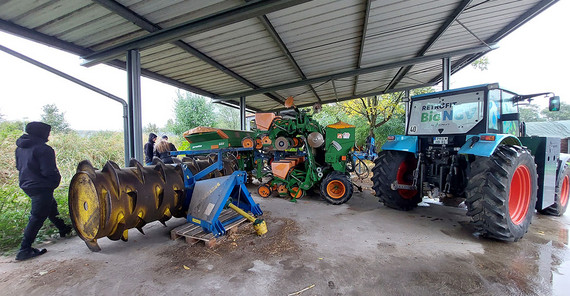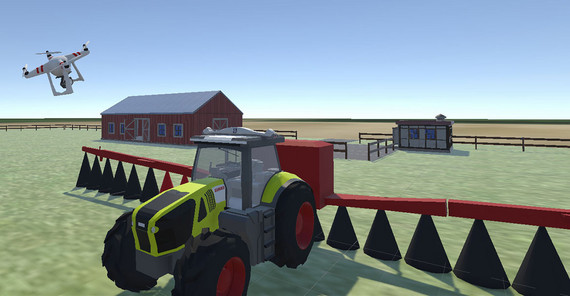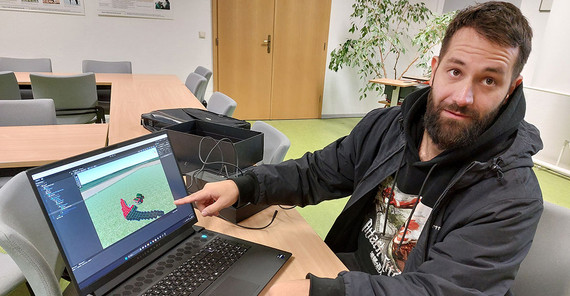The animals don’t seem to mind the cool and wet weather. While the four researchers are hiding from the weather under their hoods during the tour of the farm, the cattle are eating hay in their enclosures calmly and seemingly content. 180 dairy cattle, 80 beef cattle, 100 sucking cows, 450 sheep, and 20 goats live on the grounds of the Teaching and Research Station for Animal Breeding and Husbandry (LVAT) in Groß Kreutz. The facility cultivates 940 hectares of land and works according to the rules of a farm – but is also a place of research and education. Topics such as animal welfare, different forms of husbandry, and greenhouse gas emissions are investigated here.
However, the plans for this facility go much further: “In the coming years, the Leibniz Innovation Farm for Sustainable Bioeconomy will be built here,” explains Kathleen Bischoff, who is an experimental technician at the Leibniz Institute for Agricultural Engineering and Bioeconomy (ATB), during a tour of the farm. Managed by the ATB, the research institute will become a model farm for a bio-based circular economy that develops and tests innovative and sustainable agricultural production methods. The infrastructure of the research facility is set to be in place by the end of 2026.
Fertilizing according to need and saving resources
The researchers from the University of Potsdam and the ATB, who are on site on this cold day, are among the many actors involved in laying the first foundations for the project. They are part of a research consortium with partners from various institutions in Berlin and Potsdam who want to test and establish new technologies at the site of the future innovation farm with the research project “Knowledge-Based Precision Plant Cultivation in a Mixed Agricultural Business” – “DigiMix-PA” for short.
This wordy term “precision plant cultivation” refers to the idea of providing plants with exactly the right amount of fertilizer, water, or pesticides that they need to grow optimally. This saves on fertilizers and pesticides, increases yields and protects the environment. “At the moment, a field is usually seen as a whole and cultivated uniformly,” explains geoecologist and soil scientist Sebastian Vogel from the ATB. “Within a few meters, however, there can be major differences in soil properties and thus in fertilizer requirements, and this requires adapted management and digital tools.” The goal of “DigiMix-PA” is to bring together many of these tools and test their interaction in practice.
How can we make agriculture more precise and efficient with the help of digital applications? “Science has been researching this for over 30 years,” Vogel says. The list of existing tools is accordingly long – from GPS-supported automatic steering systems in agricultural machinery to sensors that measure nutrient levels in the soil and plants to determine fertilizer requirements, to drones that can detect unwanted weeds in the field from the air, using high-resolution cameras and artificial intelligence, and treat them with targeted herbicides. Nevertheless, there is a large gap between what already exists and what is actually used on the fields. “The existing technologies are still used far too little in agricultural practice,” he summarizes.
Many farmers are uncertain and overwhelmed
There are many reasons for this. One of them is farmers’ uncertainty as to whether the necessary investments will actually pay off at some point. In addition, there are hardly any systematic solutions that cover the entire production chain of a farm. Instead, farmers are confronted with many individual solutions that focus either on the soil, plant diseases, or nutrient supply. Last but not least, there is a lack of knowledge about the correct use of digital technology. To overcome these obstacles, researchers from the fields of agricultural and computer sciences are collaborating closely in the project.
On an experimental field of about 17 hectares, they now want to investigate in concrete terms how precision plant cultivation can be implemented in practice in an integrated way and what the financial implications on the farm and the ecological impact on the environment are. “We want to combine and unite the many individual practical solutions and completely digitize the farm with all its processes, using nitrogen fertilization as an example,” Vogel explains. A 5G campus network is being purchased specifically for the tests in order to transmit the various data from working machines, drones, and sensor networks in real time. Last but not least, the aim is to provide farmers with concrete assistance to make the transition easier. “Because the research results show it’s worth it,” he emphasizes.
The first step is a comprehensive and precise mapping of the soil, in which the researchers scan it with various sensors to determine the pH value, humus content, and soil texture in high resolution. The field studies will then start in 2024, in which the nitrogen will not be fertilized evenly, as has been the case to date, but according to need. To calculate how high the nitrogen fertilization requirement actually is, the researchers will use the soil data from the soil sensors and also measuring devices that determine the nitrogen supply to the plants. There are already sensors on the market that can be attached to a tractor, for example, and that measure, while driving across the field, whether the plants lack nutrients or are well supplied.
Is it profitable?
In order to fertilize on a needs basis, researchers need to know how much nitrogen the plants require in their respective locations and in their individual growth phases. On the other hand, it needs new technical solutions because the centrifugal spreaders used to date cannot distribute the fertilizer precisely enough across the field. For their experiments, the researchers are using so-called pneumatic fertilizer spreaders, which can place the fertilizer granules with almost pinpoint accuracy and variability. In addition, the nitrogen is not only applied to the field through mineral but also organic fertilizer. This means that the liquid manure produced by the livestock on a mixed farm is used as a valuable source of nitrogen, and material cycles are closed. A state-of-the-art slurry tank with an integrated sensor is purchased for this purpose. It measures the nutrient content of the liquid manure quickly and accurately as it is filled and spread and adjusts the quantity according to requirements.
At the end of the tests, they look at the results of the various fertilization scenarios: How high are the costs caused by the changed operating procedures? How many additional working hours do they require? What effect does all this have on the farm's yield and profit? Can fertilizers be saved? Will less pollutants be released into the air or groundwater with the adapted fertilization?
Knowledge about material cycles, ecology, and economics is one thing. Another is the farmers who have to put that knowledge into practice – and have often been pretty much left alone so far. “It’s a huge change for farmers to accept digitalization and integrate it into their business processes,” Bischoff explains. “Operating resources are becoming more expensive, labor is scarce and, as a farmer, you really have to weigh carefully which measures to implement and how cost-intensive these measures are.” She has observed that young farmers are more willing to use new digital methods than their older colleagues. “However, the majority is not yet convinced, uncertain, or sometimes overwhelmed.”
Tractor training and time travels in virtuality
This is where computer science professor Ulrike Lucke from the University of Potsdam comes in: “Ultimately, we are using digital technology here for motor skills. And I don’t acquire these by sitting at a desk and clicking my way through somewhere, but by moving and practicing the process with my body.” Her colleague Florian Nowotny demonstrates what this can look like. “Please put them on,” he says as he hands over a pair of VR glasses. These glasses open the door to a virtual world, while the reality of the office with desks, chairs, and the people you are talking to disappears. Anyone wearing the glasses and reaching for the displayed key will find themselves in a chugging tractor that can be steered across a field using two joysticks. Various fertilization scenarios can be simulated and evaluated. A color code on the monitor shows, for example, where too much or too little fertilizer is being applied and what differences there are between the centrifugal fertilizer spreader and the more precise pneumatic fertilizer spreader: Red means there is too much fertilizer on the field, green means the quantity is optimal and corresponds to the actual requirement. The menu also allows you to quickly switch from the tractor to the drone: You suddenly have a virtual bird's eye perspective of the field and can see the results of your work and the effects on the surrounding area.
The application is still in its initial stage and will be gradually expanded over the coming years. “We want to create a low-threshold learning environment for farmers that demonstrates how the various technical components work together and how they can be used in a reasonable way,” Prof. Lucke explains. On the one hand, the use of new technologies can be trained and tried. On the other hand, the consequences of one’s own actions are made visible. What are the differences between automated and manual fertilization? What will happen to the neighboring lake in five or ten years if the fields are over-fertilized? How does the soil change during this journey through time? Will my farm still be productive and profitable in 30 years if I continue to farm as before? Various scenarios of the VR application will show all this in the future if they are linked to the experimental data.
It is still a matter of defining the individual learning objectives and developing meaningful simulations. The potential is already evident: “Such immersive technologies have a great learning effect,” Lucke is convinced.
“When you are in a virtual reality and part of the whole, it is quite easy to feel affected: It affects me when my actions cause the lake to tilt or the climate to change. We want to investigate what learning effects we can bring about through this change of perspective,” she says, explaining one of her research objectives. This learning effect could also be helpful for the training of future farmers or for demonstration purposes at agricultural trade fairs. As a computer scientist, Prof. Lucke does not find it difficult to think her way into agronomic topics. “Of course, it involves a lot of research. But the subject is not too distant for me. As a child, I wanted to become a zookeeper,” she says and laughs.
The Researchers
Prof. Ulrike Lucke has been Professor for Complex and Applied Multimedia Architecture at the University of Potsdam since 2010. She is head of the sub-project Transfer of the DigiMix-PA research project that transfers results of the other sub-projects into VR-based learning applications.
Email: ulrike.luckeuuni-potsdampde
Florian Nowotny has been a research assistant at the Department of Computer Science since 2019.
Email: fnowotnyuuni-potsdampde
Dr. Sebastian Vogel is a specialist in soil science. He is group leader of the working group Proximal Soil Sensing at the Leibnitz Institute for Agricultural Engineering and Bioeconomy (ATB) and coordinator of the DigiMix-PA project.
Email: SVogeluatb-potsdampde
Kathleen Bischoff is an experimental technician for plant cultivation at the Leibnitz Institute for Agricultural Engineering and Bioeconomy (ATB). She works in the project Leibnitz Innovation Farm for Sustainable Bioeconomy.
Email: KBischoffuatb-potsdampde
The Project
In the project “DigiMix-PA – Science-Based Precision Plant Cultivation in a Mixed Agricultural Business”, researchers develop practice-applicable solutions for a digitalized production chain in a mixed agricultural business.
Participants: Helmholtz Centre Potsdam - GFZ German Research Centre for Geosciences, Leibniz Institute for Agricultural Engineering and Bioeconomy (ATB), Technical University Berlin (TUB), University of Potsdam (UP)
Duration: 12/2022 - 12/2025
Funding: Federal Ministry of Food and Agriculture
Project: https://www.atb-potsdam.de/de/forschung/forschungsprojekte/projektsuche/projekt/projekt/digimix-pa
The Leibniz Innovation Farm
New concepts are needed for sustainable agriculture of the future. The prospective Leibniz Innovation Farm for Sustainable Bioeconomy (InnoHof) is testing what these could look like. The existing farm will be expanded into a model farm, which will be further diversified, digitalized, and expanded to include a research biorefinery. The farm will be used to test how a circular bioeconomy that uses all accruing raw and residual materials most efficiently and produces as little waste as possible can look in practice. In the future, innovative processes and technologies will be used to cultivate algae, raise insects, process natural fibers, produce biochemicals, and make optimum use of residual materials in the integrated biogas plant. The Leibniz Institute for Agricultural Engineering and Bioeconomy (ATB) leads the project and cooperates with numerous other research institutions to establish the Innovation Farm as a model farm. In the future, Leibniz institutions, universities, and non-university research institutions will conduct joint research here on interdisciplinary and transdisciplinary issues. Farmers and consumers will benefit from the research findings through an intensive transfer of knowledge and technology. The development of the model farm is supported with funds from the state of Brandenburg.
Website: https://leibniz-innohof.de
This text was published in the university magazine Portal Wissen - Eins 2024 „Bildung:digital“ (PDF).



